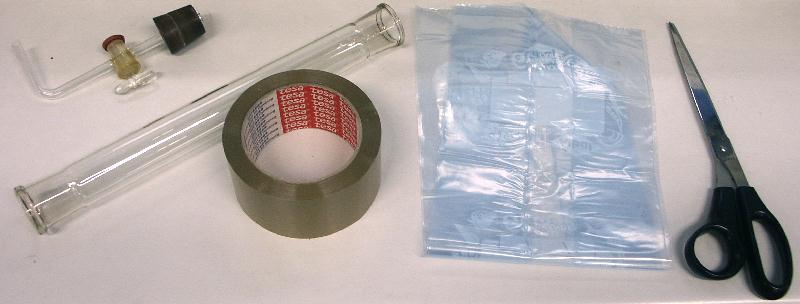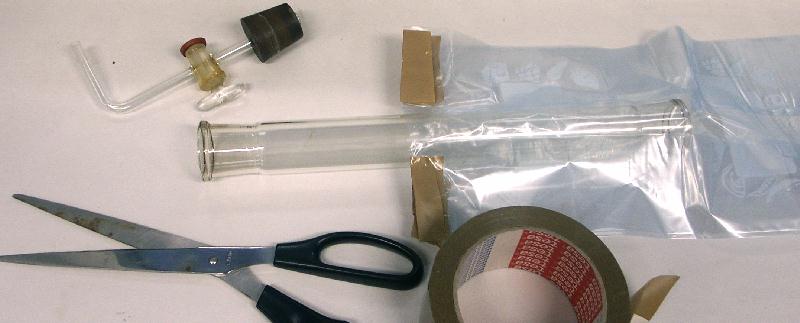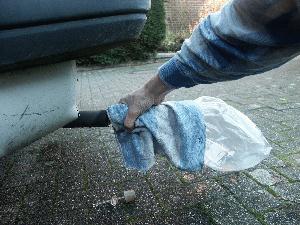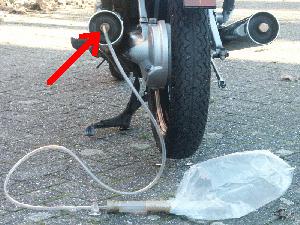 > ENC Master > Climate Encyclopaedia > Climate in Cities > more > 1. Air Pollution > * Worksheet 1
> ENC Master > Climate Encyclopaedia > Climate in Cities > more > 1. Air Pollution > * Worksheet 1
 |
|
|
|
|
|
|
|
Climate in citiesRead more |
Worksheet 1Air contaminants from exhaust gases of motor vehicles
This worksheet may help you to find out something about the content of exhaust gases as well as the effect of catalytic emission reduction of exhaust gases.
|
|
|
|
Exhaust gases are hazardous to your health and should therefore not be inhaled! If possible use a fume hood or work outside. Some useful information for the experiments: Chemicals you need: Be careful: Some chemicals used in the experiment are harmful. Experiment carefully and protect yourselves!
Preparation of the Saltzmann-solution (detection agent for nitrogen oxides, that form nitrous acid with water): 5g sulfanilic acid, 0,050g N(1-naphthyl)ethylenediamine dihydrochloride and 50ml acetic acid are dissolved in 800ml water. The solution is then filled up to 1L. In the absence of light and air the solution can be stored for months. Materials needed for each group (depending on the pupils´ planning there might be other or more materials needed as well ):
|
1. Preparation and sample collection of exhaust gas in freezer bagsYou need sample collection bag in order to collect and transport your samples of exhaust gas. You can take different kind of bags but we propose commercial freezer bags (without fastener). Before using them as collection bags they have to be modified as follows: materials needed for each bag:
|
|
|
The glass tube should be placed at the middle of the open side of the plastic bag and should reach far into the bag. In order to seal the bag, apply tape first to the sides of the bag, wrap the sides around the glass tube and tape again tightly (see pictures 1-3 ). |
|
|
|
2. Taking the sample |
|
You can usually take the sample by removing the stopper, wrapping the end of the glass tube with a piece of cloth, removing all air inside the bag, placing the glass tube tightly at the end of the exhaust pipe (see picture no. 5). "Wash" the bag once with exhaust gas before taking the actual sample. As soon as the bag is filled with gas for a second time attach the stopper to the glass tube, c.f. picture no. 4 (after having closed the pinchcock). |
|
If the procedure decribed above is not possible proceed as follows: Take a glass tube and attach a cork stopper to one end. The stopper should also fit the vent of the exhaust pipe. The other end of the glass tube is connected to the glass tube of the collecting device via a rubber hose (see picture no. 6). For this alternative a greater gas pressure is needed. Therefore it is necessary to close all vents which are connected to the vent where the sample is taken with cork stoppers. If you vary the immersion depth of the stopper (arrow in picture no.6) you can change the gas pressure so the motor keeps running. |
|
||||||||||||||||||||||||||||||||||||||||||||||||
3. Qualitative analysis of exhaust gas (CO, CO2 und NOx)
Information on the identifications: 1. Identification of carbon monoxide with an ammoniac solution of silver nitrate:
2. Identification of carbon dioxide with lime water (aqueous solution ofcalcium hydroxide):
3. Identification of nitrogen oxides with Saltzmann solution:
|
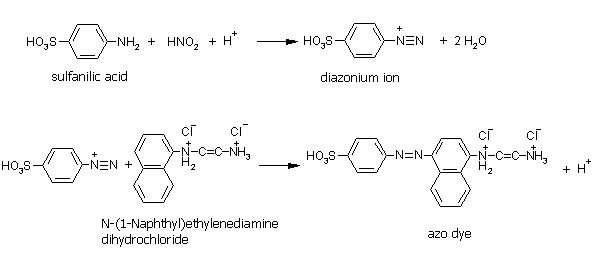 |
|
Picture 7: The reaction scheme of the nitrogen identification with Saltzmann solution.
|
|
Exhaust gases contain substances that are hazardous to your health: When carrying out the experiments use a fume hood or work outside !
|
About this page:Authors: M. Seesing, M. Tausch - Universität Duisburg-Essen, Duisburg / Germany
|



